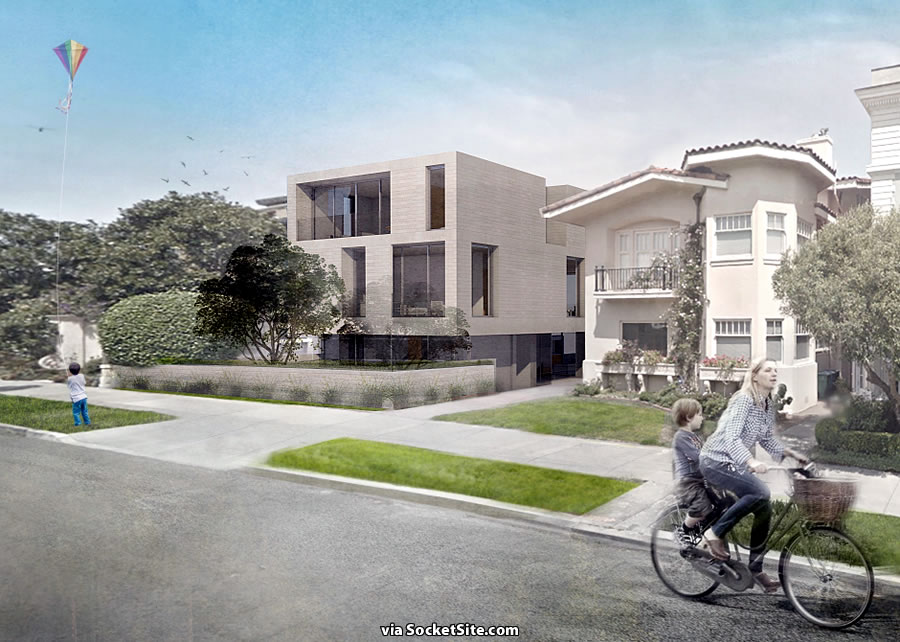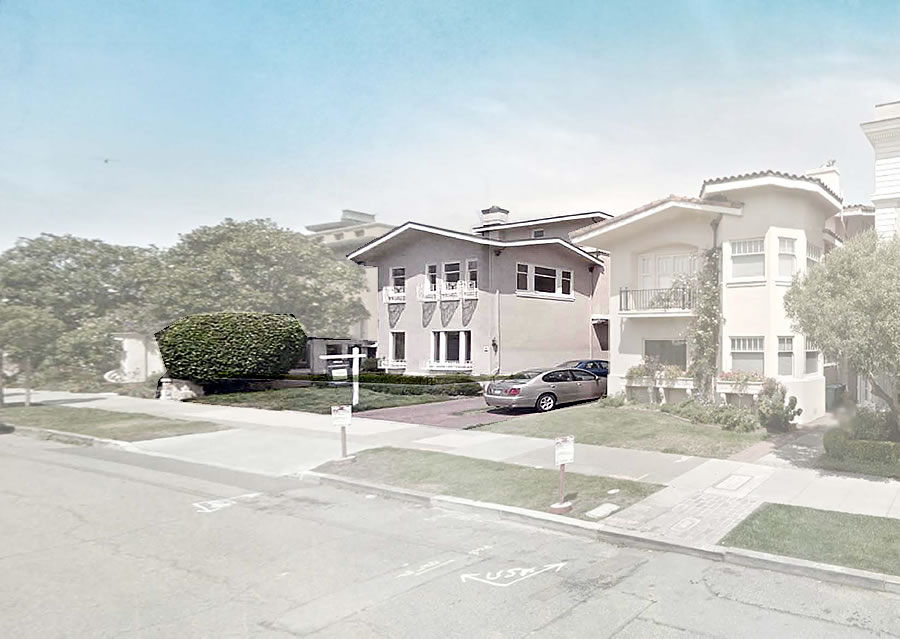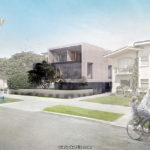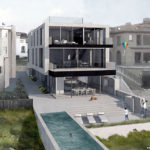As we first revealed back in November of 2017:
Purchased as an oceanfront “fixer” for $11 million in April of 2015, plans to demolish the existing 4,600-square-foot home at 178 Sea Cliff Avenue are in the works. And as envisioned, a modern 10,400-square-foot mansion, which includes a 2,000-square-foot basement garage, will rise up to 30 feet in height upon the Sea Cliff site.
As designed by Butler Armsden Architects for the Danish co-founder of Bestseller Fashion Group China, the proposed six-bedroom home features walls of windows overlooking the ocean and Golden Gate Bridge and an infinity edge pool.
With the plans having since been refined and granted an environmental clearance to proceed, demolition and building permits for the project have been requested and triaged. And the project, as newly rendered below, has now been formally challenged as well.
From a requested Discretionary Review (DR) which is now seeking to block the project as proposed:
“The proposed design of the new structure will result in an exceptional departure from the design elements of neighboring homes which, taken together, form one of the City of San Francisco’s (the “City”) unique residential districts worthy of historic preservation.”
“Based on our review, the new home incorporates modern and minimalist elements better suited for some of the City’s newer communities, but not for an existing eclectic neighborhood. The architect has proposed a gray three-story cube seated upon a recessed, one-story pedestal according to renderings of the new building.
Windows and balconies are of irregular shapes and are placed asymmetrically across the structure. As proposed, the new residence is incompatible with the Seacliff (sic) neighborhood, which boasts homes of similar, yet more traditional, materials, style, massing and scale. Thus, a concrete cube does not conserve the more traditional design of the existing neighborhood.”
“As provided in the City’s Historical Resource Evaluation Response concerning the new building at 178 Seacliff (sic), the Sea Cliff neighborhood is comprised of large single-family homes in the “French/Mediterranean, Spanish Revival, Edwardian, and hybrid Arts & Crafts/Tudor styles.” The original Sea Cliff design guidelines provide a “high level of architectural consistency” throughout the neighborhood.
[And] although Planning Department staff did not conclude the existing structure at 178 Seacliff (sic) Avenue to be of individual historic import, the building is eligible for inclusion on the California Register as “a contributor to the potential Seacliff (sic) historic district.” Contributor homes embody the “massing, design, and materiality” characteristic of early Sea Cliff homes. Indeed, the Planning Department even concluded that the “overall design of” the Project proposal “is not compatible with the character of the eligible district.” That is, a three story cube does not look anything like the smaller one and two story Mediterranean and Tudor style homes that line both sides of Seacliff (sic) Avenue.”
“Accordingly, my Client asks that the Planning Department find that discretionary review of the proposed Project must be conducted by the Planning Commission to determine revisions to the Project so that the new home will be compatible with the architecture, design, massing and scale of the surrounding homes and the Seacliff (sic) Historic District.”
Also noted, “the Project also blocks views for my Client at 164 Seacliff (sic) and its neighbors immediately adjacent.”
We’ll keep you posted and plugged-in.




> eligible for inclusion on the California Register as “a contributor to the potential Seacliff historic district.”
“If such a district were to be created, there is no law that prohibits this building from being considered a contributor to it.”
And we wonder why there’s a housing crisis.
The potential establishment of a historic district in Sea Cliff would have no effect on the housing crisis in the Bay Area. Nobody is proposing to build affordable housing there.
And the potential construction of this proposed home would do nothing to help people unable to afford homes here.
You’re missing the point entirely; which is that SF residents have become far too comfortable holding up totally fine projects and ultimately the creation of homes (affordable or otherwise) for what tends to be entirely subjective and inane reasons. The story above just highlights the asinine systemic issues that SF should counter if it genuinely wants to address the crisis.
Also, building affordable housing isn’t not the only factor that will ease the problem. It might not even be the most viable option. We need all types of housing, some of which will include ‘modern’ homes that feel slightly out of context and we absolutely do not need San Francisco to continue to use the ‘historic district’ argument as a way to block new construction.
If that was “the point”, it shouldn’t have been wrapped in false concern about the housing crisis. The people who live in this home are not victims of the housing crisis…they can afford to live almost anywhere they want.
Again, blocking redevelopment in one of the wealthiest single-family neighborhoods of San Francisco has zero effect on creating housing for poor and middle class folks.
Your shortsightedness here is missing the previous post’s points.
@billparks: I am largely in agreement with Bobby Mucho’s comments. What I disagree with is the earlier commenter’s use of false economic arguments about affordable housing as support for a wealthy person’s interest in redeveloping a site in an exclusive neighborhood.
None of my comments were intended as taking a position on this particular proposed project. I am just against faulty logic.
Uh, how exactly is demolishing a very large single family home and replacing it with grotesquely large (10,000 sf!) single family home contributing anything to improving the housing crisis? This fight has nothing to do one way or other with our housing issues. It is however a terrible waste of embedded energy and natural resources to tear down a perfectly functional large house and rebuild a new one just because you don’t like the style. It would probably take a century or more of a new hyper-efficient house to have a net positive environmental benefit over the existing structure.
There is no indication that this home is in “perfectly functional” condition. To the contrary, a lot of these homes are in severe need of repair and it can be far less expensive and wasteful to gut them or tear them down and build something more energy efficient.
You could say that about demolishing any building. If you are making the eco-friendly argument, then you should support a ban on demolishing any structure, so long as it is not a hazard, not just singling out this one particular house. I wish people would stop hiding behind phony arguments on this site. You don’t like this particular development proposal, fine. Own your opinion and stop preaching.
Oh yeah, I remember. This is the one with the kiddie kite obsession.
On the street a child is being carried on a bike un-helmeted, and in the back another is flying a kite….next to a cliff !!
Forget the design issues: we need Child Protective Services notified.
remember the client is Danish – the Danes bike without helmets (with fewer head injuries than in US)!
“for the Danish co-founder of Bestseller Fashion Group China” That there tells you everything that is wrong with SF and the Bay Area. Big spenders from out of town who make zero contribution to SF.
So paying sky high real estate taxes to support/improve dilapidated schools and a burgeoning SF City Government in your mind equals “zero contribution to SF?”
Exactly – Your comment clarifies it. It’s a failed argument we have been hearing for decades.
I believe the premise is that if the person lived here full time, they would be more motivated to improve either/both of these governing failures. (A premise, mind you, whether/not it’s actually true is certainly arguable)
So I guess the first question to be answered is will Mr. Povlsen (or Friis or Warburg…which of these “Danish founder”s it actually is is unclear) live here full time, or instead in Brande or Copenhagen or …wherever else…
Perhaps a case of Carlsberg would assuage Mr. 164 Seacliff….or not
Seacliff ain’t Malibu. Redesign.
Just like all those dirty gold rushers, right?
“zero contribution” Have you heard of property tax?
Neighbors will probably lose. The Richmond Special at 255 Sea Cliff got through.
I’m still puzzled by the evaporation of value when one buys a tear down for $15mm and then spends another $5-10mm to get a $10mm house. ¯_(ツ)_/¯ (I’m pretty sure I don’t have enough money to understand…)
No offense meant –
But
If you have to ask then you’re not the target market for this sort of purchase….
Builders are quoting closer to $3,000psf for projects like this. So the owner could well be in for $45MM+ when it’s all said and done.
not the best looking project, but if this mausoleum is okay for the ‘hood, or if this place in Pac Heights is okay, then these pearl clutchers need to simmer down.
Exactly. It’s much more compatible than those examples.
Or as we actually noted over a decade ago, “while modern architecture isn’t everybody’s cup of tea, if it can happen here (amongst the Pacific Heights mansions) perhaps it can happen anywhere (without “denigrating” the character of the neighborhood).”
The key line from above, however: “…the Project also blocks views for my Client at 164 Seacliff (sic) and its neighbors immediately adjacent.” But views aren’t protected in San Francisco (as opposed to architecture, light and air).
Agreed, the view comment was a misguided move by the attorney. And misspelling Sea Cliff so many times will not garner any sympathy.
[see Editor, we actually agree sometimes!]
I am not sure that it is disruptive because it is modern….Sea Cliff does have a few midcentury gems…..but that it is as big as an aircraft carrier.
Also, nobody is going to miss this old house.
Liked the wood floors and paneling, though. But banal to the max otherwise.
The protesters even call it an “eclectic neighborhood” in their DR. If it’s eclectic, a modern box fits right in, that’s the very definition of the word eclectic. To me, this proposed remodel actually fits the neighborhood more than the old place. The old place looks dumpy and the new place looks richie rich…which is the true nature of this neighborhood.
Bottom line is that there is just no reason the owner of this property shouldn’t be allowed to build a home he likes except that it doesn’t accord with the architectural taste of the neighbors which shouldn’t matter at all. They don’t have to live in the home and they’ll get used to it. There are mid-century modern homes in Seacliff as well as the older styles like the one next door to this proposal. City neighborhoods should be allowed to evolve with the times as long as it’s one property at a time and not wholesale bulldozing of blocks as in 1950s style “urban renewal”.
nice design. show us the floor plan.
Reminds me of the concrete bunker out south in Pacifica at devil’s slide… eventually this will all be in the shark soup of the bay…
Do you want the clean, light-filled, open-living structure on the left, or the moldy, stuffy, cloistered structure on the right?
Butler has a reputation as the go to firm to [get] things permitted. Pass the popcorn.
This was the design with the crazy hidden garage entrance right?
That’s correct.
Ever wonder how these people live beside each other after years of fighting? Such a rough welcome to the neighborhood. Like always, its probably about the blocked view more than anything.
The majority of the time, they probably don’t– live there, that is. And it’s not like they’ll ever need to borrow a cup of sugar or ask for emergency babysitting.
I’ve run across this phrase before: “possible contributor to a potential historic district.” Until the building is determined to be a actual contributor to an established historic district, the planning department should have no say.
Laughed a little out loud at the definition of the neighborhood as ” French/Mediterranean, Spanish Revival, Edwardian, and hybrid Arts & Crafts/Tudor styles” since none of these have any relationship to each other anyway.
Not to mention a fair sprinkling of midcentury modern houses and a Japanese inspired design at 50 McLaren Ave.
There’s no law against getting on an airplane in a wife-beater having not showered for a week. Nor one against farting loudly in an elevator. There’s no law one could draft that would prevent this kind of inconsiderate and clueless insult to a neighborhood streetscape without it feeding red meat to the NIMBYs.
It’s called a sense of community , folks. Plopping an LA monstrosity into a place it does not belong is just self centered and rude, like the Asperger-y clueless techies who ride their little toy scooters on the sidewalk.
Simply put, in the same way you cannot prevent the unshowered wife beater wearer from boarding the plane – people are free to do what they want with their property within the limits of the planning code. The rest of your screed is what you claim the “aspergery clueless techies” are – self centered and rude.
If you have a city (and a region) where people arrive from all over the world, from hundreds of different cultures, live here for a while in order to work and accumulate capital and then mostly leave after a relatively short while because the area’s cost-of-living actively thwarts family formation, it should not be surprising that maintaining “a sense of community” is difficult.
Yep, people are free to be a-holes, and ignore what their neighbors, seat-mates, or anybody else thinks. They just should not start whining when people call them what they are: self-centered, rude a-holes.
UPDATE: The requested Discretionary Review (DR) of the project has been rejected by San Francisco’s Planning Commission and the application for the home’s building permit has been approved.
And on a related note, plans to raze an even more expensive ($16 million) Sea Cliff home and build another modern mansion designed by Butler Armsden Architects are in the works.
Out of curiosity, where are we able to see the status of documents like this?
That’s good news indeed. The appellants should look up the definition of ‘eclectic’ because having a different style mixed into the neighborhood actually strengthens that notion.
Yay! San Francisco housing crisis solved!!
UPDATE: The demolition and building permits for 178 Sea Cliff have been issued and bigger plans for the neighboring home have now emerged.